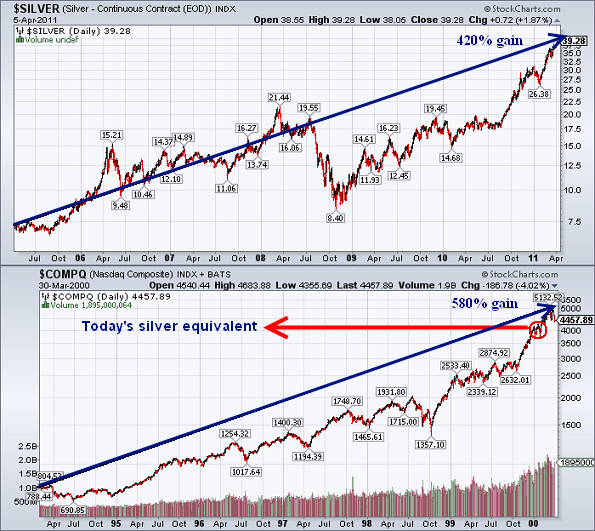What if someone had come to you at Nasdaq 3900 in late 1999 and told you that the Nasdaq was going to decline 80% over the next few years? Would you have gotten out after such a great run or would you have continued pouring money into an environment that surely felt “different this time”? What if I told you your upside was capped at 30% and your potential downside was 80% over the course of the next 36 months? Would you take that bet? This might be the exact situation we are looking at with the price of silver today.
If you study the Nasdaq bust and the prior 6 year rally in silver prices you will see some remarkable similarities. After settling at around $7.50 in 2005 silver prices went on a 420% tear to their current price over $39. In 1994 the Nasdaq Composite settled around 750 before prices went on a 6 year 520% tear to their all-time high of 5132. The 3900 level in late 1999 was the equivalent of today’s $39 price in silver. It was a full 30% shy of the top, however, a seller at that level in 1999 avoided a 72% decline in the coming years.

Now, I know history never repeats perfectly, but it does have an odd way of rhyming. The 6 year action in silver and the Nasdaq are eerily similar. It’s impossible to say whether silver is currently in a bubble because there are so many catalysts driving prices higher, however, the price action is remarkably similar to past bubbles. But is silver really in a bubble? Let’s review some characteristics of bubbles.
First, a “bubble” occurs when market forces combine to generate a highly unstable position. This results in the system entering an extreme disequilibrium and ultimately failure. Characteristics of bubbles:
- Strong fundamental underpinnings. Bubbles do not merely appear out of nowhere. Bubbles grow over a period of time based on strong fundamental underpinnings. There is always a very good economic reasoning behind bubbles. This feeds into the rationalization of its existence and justifies a “it’s different this time” mentality that later occurs.
- Ponzi builds. A naturally occurring ponzi process begins. As a recency bias builds (the tendency to overweight recent events and ignore historical facts) the system begins to exhibit herding behavior as more and more investors get in on “the only game in town”. This becomes amplified by the media, those with a vested interest in this particular market, those who “throw in the towel” after wrongly betting against the trend, etc.
- Illusion of stability within disequilibrium. The illusion of control increases as investors become increasingly confident in the market. They increase their bets, increase price targets, etc. Investors begin to convince themselves that it is “different this time”. All of this is occurring as the system grows increasingly unstable. I like to think of it like a spinning top. When you initially throw a top into a tight spin there is a distinct order in its movements. They are predictable and stable. But as the top loses momentum it begins to spin uncontrollably. The system becomes unstable, unpredictable and ultimately breaks down. Bubbles work within the same sort of illusion. What appears like a stable and self sustaining system is in fact increasingly unstable and entering an inevitable disequilibrium that breaks down.
- Systemic collapse. All bubbles collapse. It is never “different this time”. As this prior herding effect begins to breakdown there is a flood for the exits as the herd reverses its controlled march into a panicked stampede. The gig is up. Collapse ensues.
Is silver in a bubble? No one can be certain, but this market is surely displaying some bubbly characteristics. Given the history of bubbles (such as the Nasdaq) and the various characteristics of bubbles we can see that silver would certainly qualify as being a “high risk” bubble market. This does not necessarily mean it is on the verge of collapse (as we saw with the Nasdaq the bubble grew further before collapsing), however, I would characterize the silver market as being in a highly unpredictable and unstable state given its current market characteristics.
Mr. Roche is the Founder and Chief Investment Officer of Discipline Funds.Discipline Funds is a low fee financial advisory firm with a focus on helping people be more disciplined with their finances.
He is also the author of Pragmatic Capitalism: What Every Investor Needs to Understand About Money and Finance, Understanding the Modern Monetary System and Understanding Modern Portfolio Construction.

Comments are closed.